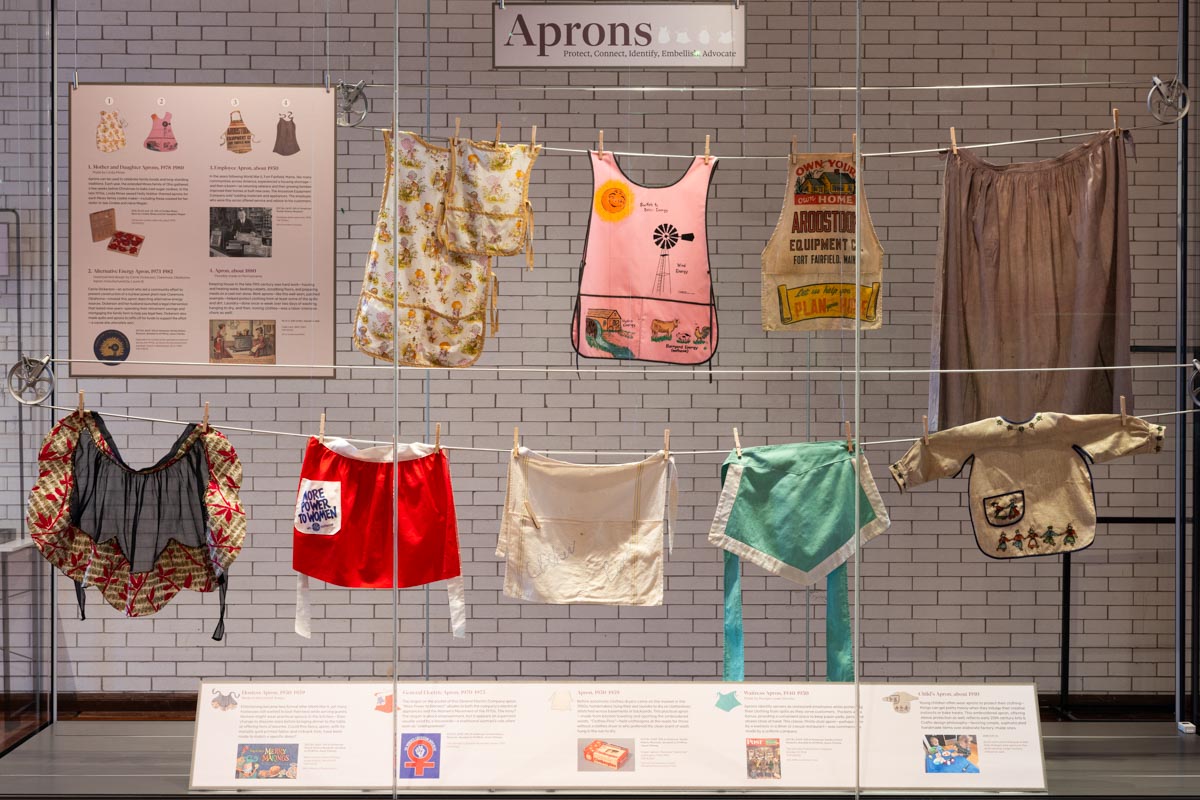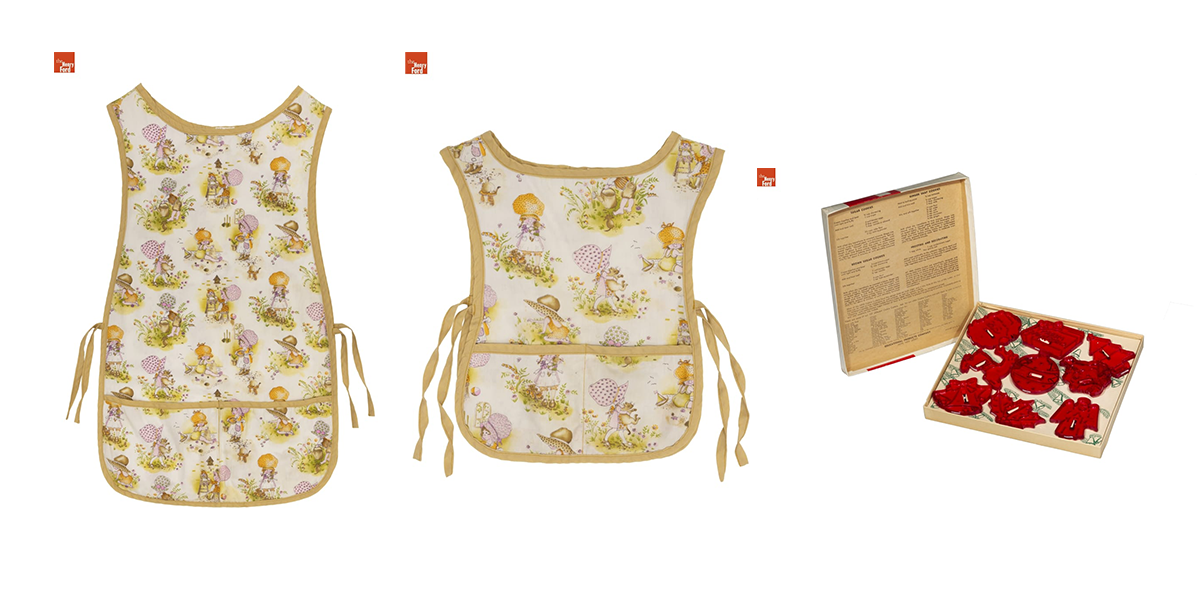What We Wore: Aprons

The current What We Wore exhibit in Henry Ford Museum of American Innovation, on display until April 17, 2024, features aprons that protect, connect, identify, embellish, and advocate.

Left: Mother and daughter aprons worn by Cindee Mines and her daughter Megan, 1978-1980. Gift of Cindee Mines. / THF370635, THF370633. Right: Christmas cookie cutter set, about 1970. / THF190022
Aprons can be used to celebrate family bonds and long-standing traditions. Each year, the extended Mines family of Ohio gathered a few weeks before Christmas to bake iced sugar cookies. In the late 1970s, Linda Mines sewed Holly Hobbie-themed aprons for each Mines family cookie maker, including these created for her sister-in-law Cindee and niece Megan.

Left: Alternative energy source apron hand-painted by Carrie Dickerson, 1973-1982. Gift of American Textile History Museum, donated to ATHM by Joyce Cheney. / THF370629. Right: Opposition to nuclear power gained momentum during the 1970s, as shown by this button from a protest march in Washington, DC., in 1980. / THF713075
Carrie Dickerson — an activist who led a community effort to prevent construction of a nuclear power plant near Claremore, Oklahoma — created this apron depicting alternative energy sources. Dickerson and her husband launched a legal intervention that lasted nine years, spending their retirement savings and mortgaging the family farm to help pay legal fees. Dickerson also made quilts and aprons to raffle off for funds to support the effort — a cause she ultimately won.

Left: Work apron, Aroostook Equipment Company, about 1950. Gift of American Textile History Museum. / THF197574. Right: Hardware store salesman, 1938. Gift of Ford Motor Company. / THF713064
In the years following World War II, Fort Fairfield, Maine, like many communities across America, experienced a housing shortage — and then a boom — as returning veterans and their growing families improved their homes or built new ones. The Aroostook Equipment Company sold building materials and appliances. The employee who wore this apron offered service and advice to his customers.

Left: Apron, about 1880. Gift of Mrs. Harold G. Hall. / THF370639. Right: Trade card, 1880-1885. Gift of Jeanine Head Miller. / THF110756
Keeping house in the late 19th century was hard work — hauling and heating water, beating carpets, scrubbing floors, and preparing meals on a cast-iron stove. Work aprons — like this well-worn, patched example — helped protect clothing from at least some of the spills and dirt. Laundry – done once a week over two days of washing, hanging to dry and then ironing clothes — was a labor-intensive chore as well!

Left: Hostess apron, 1950-1959. Gift of American Textile History Museum, donated to ATHM by Joyce Cheney. / THF370653. Right: "Betty Crocker's Merry Makings" recipe booklet, about 1963. / THF713078
Entertaining became less formal after World War II, yet many hostesses still wanted to look their best while serving guests. Women might wear practical aprons in the kitchen, then change to dressier ones before bringing dinner to the table or offering hors d'oeuvres. Could this fancy apron, with its metallic gold printed fabric and rickrack trim, have been made to match a specific dress?

Left: General Electric apron, 1970-1975. Gift of American Textile History Museum, donated to ATHM by Joyce Cheney. / THF370647. Right: "The Women's Liberation Movement" poster, 1970. / THF92260
The slogan on the pocket of this General Electric Company apron, “More Power to Women,” alludes to both the company’s electrical appliances and the women’s movement of the 1970s. The irony? The slogan is about empowerment, but it appears on a garment usually used by a housewife — a traditional woman’s role often seen as “unempowered.”

Left: Clothespin apron, 1950-1959. Gift of American Textile History Museum, donated to ATHM by Joyce Cheney. / THF197572. Right: Munising Sunny Day clothespins, 1953-1955. Gift from the Collection of Susan Strongman Fiems by Dennis Fiems. / THF153357
Before automatic clothes dryers came on the market in the 1950s, homemakers hung their wet laundry to dry on clotheslines stretched across basements or backyards. This practical apron — made from kitchen toweling and sporting the embroidered words, “Clothes Pins” — held clothespins at the ready for those without a clothes dryer or who preferred the clean scent of wash hung in the sun to dry.

Left: Waitress apron, 1940-1950. Gift of American Textile History Museum, donated to ATHM by Joyce Cheney. / THF197568. Right: The Saturday Evening Post magazine, October 12, 1946. / THF288251
Aprons identify servers as restaurant employees while protecting their clothing from spills as they serve customers. Pockets are a bonus, providing a convenient place to keep paper pads, pens, and straws close at hand. This classic 1940s-style apron — perhaps worn by a waitress in a diner or casual restaurant — was commercially made by a uniform company.

Left: Child’s Apron, about 1910. / THF370661. Right: Byram and Autumn Rodriguez of Allen Park, Michigan, wear aprons as they enjoy painting. Image courtesy of Reanna Lewis.
Young children often wear aprons to protect their clothing; things can get pretty messy when they indulge their creative instincts or bake treats. This embroidered apron, offering sleeve protection as well, reflects early 20th-century Arts & Crafts design philosophy — favoring simple, sophisticated handmade items rather than elaborate factory-made ones.
Jeanine Head Miller is curator of domestic life.
To see more aprons from The Henry Ford's collections, click here.
